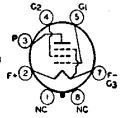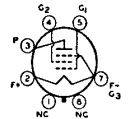01-07-2024, 08:39 PM
Very nice job on that chassis, Chip! 


What output tube to use depends on what output transformer that you can get your hands on. The following chart may be useful (Data from RCA Receiving Tube Manual Version RC24):
Tube Base Diag Grid Bias Output Impedance Type
1A5 6X -4.5V 25,000 Ohm Power Pentode
1C5 6X -7.5V 8,000 Ohm Power Pentode
1G5 6X -6.0V 8,500 Ohm Power Pentode
1Q5 6AF -6.6V 8,000 Ohm Beam Power Pentode
3Q5 7AP -6.6V 8,000 Ohm Beam Power Pentode
Of all the tubes listed, the 3Q5 is likely the most common, as it was used in battery / line power portables. 1Q5 and 3Q5 are the best choice if an output transformer with 8K Ohm primary is available to you. The tubes and output transformers are quite common and deliver the most power output of all of the choices. However, the bias resistor may have to be adjusted based on the tube current and required grid bias. Try a 390 Ohm resistor if using an AC power supply to obtain the 90VDC B power. Most RCA sets using the 1Q5 or 3Q5 use this resistor. A higher value will reduce current, acting as a "battery saver" but will lower output and may increase distortion.
The 1A5 is a good choice if it is available and a good output transformer with 25KOhm impedance is available. No modification is required, but the power output is much less than the 1Q5 or 3Q5 (100mW vs 400mW). Sets that use the 1LA4 output will have a 25KOhm transformer and would be a good donor set, as the 1LA4 and 1A5 have similar specs but different pinouts.
Pin connections for the 6X Pentode and 6AF Beam Power socket diagrams are essentially the same. Pin 7 is chassis ground and A battery Negative (A-). Pin 2 is A+ To convert to the 7AP diagram used by the 3Q5, pins 2 and 7 are connected to each other and A+ and Pin 8 is connected to A- and chassis ground.
Pin Diagrams below:
1A5, 1C5, 1G5:

1Q5 (Note similarity to 1A5 pinouts):

3Q5:

This set, like almost all 1.5V / 90V farm or battery only portabes use a "PM" (permanent magnet) speaker. AlNiCo (Aluminun / Nickel / Cobalt alloyed to Iron) Magnets were just becoming available in 1940. Earlier PM speakers had an extremely large magnet structure.
Comment added 01/08/24- The 1Q5 and 3Q5 are Beam-Power tubes. However, this cannot be told by the base diagrams. I don't know why RCA drew the diagrams this way. It is possible that the base diagrams are drawn by the company that invented these tubes. They were invented in 1938 by Sylvania. I believe that most Philco, Silvertone and Zenith tubes in the mid 30s were made by sylvania, based on the number stamping and location being the round Sylvania style vs the octagonal RCA style. The taller skinnier "G" version of this tube without the wafer and metal type base are definitely Sylvania design. The shorter "GT" version with the metal / wafer base are more of an RCA design. The difference may be important for the 1H5 Detector / 1st Audio and 1N5 IF tubes as these may be shielded. My BF Goodrich Mantola 419 battery portable requires the "G" style, as the GT would not fit through the shield base.
Hope all of this helps
What output tube to use depends on what output transformer that you can get your hands on. The following chart may be useful (Data from RCA Receiving Tube Manual Version RC24):
Tube Base Diag Grid Bias Output Impedance Type
1A5 6X -4.5V 25,000 Ohm Power Pentode
1C5 6X -7.5V 8,000 Ohm Power Pentode
1G5 6X -6.0V 8,500 Ohm Power Pentode
1Q5 6AF -6.6V 8,000 Ohm Beam Power Pentode
3Q5 7AP -6.6V 8,000 Ohm Beam Power Pentode
Of all the tubes listed, the 3Q5 is likely the most common, as it was used in battery / line power portables. 1Q5 and 3Q5 are the best choice if an output transformer with 8K Ohm primary is available to you. The tubes and output transformers are quite common and deliver the most power output of all of the choices. However, the bias resistor may have to be adjusted based on the tube current and required grid bias. Try a 390 Ohm resistor if using an AC power supply to obtain the 90VDC B power. Most RCA sets using the 1Q5 or 3Q5 use this resistor. A higher value will reduce current, acting as a "battery saver" but will lower output and may increase distortion.
The 1A5 is a good choice if it is available and a good output transformer with 25KOhm impedance is available. No modification is required, but the power output is much less than the 1Q5 or 3Q5 (100mW vs 400mW). Sets that use the 1LA4 output will have a 25KOhm transformer and would be a good donor set, as the 1LA4 and 1A5 have similar specs but different pinouts.
Pin connections for the 6X Pentode and 6AF Beam Power socket diagrams are essentially the same. Pin 7 is chassis ground and A battery Negative (A-). Pin 2 is A+ To convert to the 7AP diagram used by the 3Q5, pins 2 and 7 are connected to each other and A+ and Pin 8 is connected to A- and chassis ground.
Pin Diagrams below:
1A5, 1C5, 1G5:
1Q5 (Note similarity to 1A5 pinouts):
3Q5:
This set, like almost all 1.5V / 90V farm or battery only portabes use a "PM" (permanent magnet) speaker. AlNiCo (Aluminun / Nickel / Cobalt alloyed to Iron) Magnets were just becoming available in 1940. Earlier PM speakers had an extremely large magnet structure.
Comment added 01/08/24- The 1Q5 and 3Q5 are Beam-Power tubes. However, this cannot be told by the base diagrams. I don't know why RCA drew the diagrams this way. It is possible that the base diagrams are drawn by the company that invented these tubes. They were invented in 1938 by Sylvania. I believe that most Philco, Silvertone and Zenith tubes in the mid 30s were made by sylvania, based on the number stamping and location being the round Sylvania style vs the octagonal RCA style. The taller skinnier "G" version of this tube without the wafer and metal type base are definitely Sylvania design. The shorter "GT" version with the metal / wafer base are more of an RCA design. The difference may be important for the 1H5 Detector / 1st Audio and 1N5 IF tubes as these may be shielded. My BF Goodrich Mantola 419 battery portable requires the "G" style, as the GT would not fit through the shield base.
Hope all of this helps
"Do Justly, love Mercy and walk humbly with your God"- Micah 6:8
Best Regards,
MrFixr55



![[-] [-]](https://philcoradio.com/phorum/images/bootbb/collapse.png)


